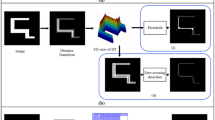Abstract
A novel approach to the 3D border determination is presented: it starts by representing the 3D object in linear octtree form, proceeds by eliminating internal boundaries between nodes of the same size while deleting internal nodes and terminates when only border voxels remain. The algorithm basically performs a mapping of the 3D object into its own border, with both input and output being represented as linear octtrees. The algorithm is shown to be executable inO(kn(N+M)) time, wherek andN are the maximum node grouping and number of nodes (respectively) of the initial linear octtree,n is the resolution of the bilevel image andM is the number of border voxels. The range of applicability of the proposed algorithm is quite wide: it can determine the external border of a simply connected region as well as the external and internal borders of a set of multiply connected objects, all at the same time.
Zusammenfassung
Eine neue Methode zur 3D-Objektgrenzen-Bestimmung wird präsentiert: sie beginnt mit der 3D-Objektdarstellung in „linear octtree form”, gefolgt von einer Eliminierung interner Grenzen zwischen Knoten („nodes”) gleicher Größe und einer Löschung interner Knoten. Das Verfahren endet mit der Feststellung, daß nur mehr „border voxels” vorliegen. Der Algorithmus führt grundsätzlich eine Abbildung eines 3D-Objektes in seinen eigenen Grenzen durch, wobei es sich sowohl bei „input” als auch bei „output” um „linear octtrees” handelt. Es wird gezeigt, daß die Exekutionszeit des Algorithmus von der Ordnungkn(N+M) ist, worink die maximale Knotenzusammenfassung undN die Anzahl der Knoten des ursprünglichen „octtrees” bedeuten.n ist die Genauigkeit des Binärbildes („bilevel image”) undM ist die Anzahl der „border voxels”. Der Anwendungsbereich des vorgeschlagenen Algorithmus ist ziemlich groß: er bestimmt die äußeren Grenzen eines einfach zusammenhängenden Gebietes genauso wie die äußeren und inneren Grenzen eines Satzes mehrfach zusammenhängender Objekte.
Similar content being viewed by others
Explore related subjects
Discover the latest articles, news and stories from top researchers in related subjects.References
Abel, D. J., Smith, J. L.: A data structure and algorithm based on a linear key for a rectangle retrieval problem. Comptr. Graph. Image Proc.24, 1–13 (1983).
Artzy, E., Frieder, G., Herman, G. T.: The theory, design, implementation and evaluation of a three-dimensional surface detection algorithm. Comptr. Graph. Image Proc.15, 1–24 (1981).
Dyer, C. R., Rosenfeld, A., Samet, H.: Region representation: boundary codes from quadtrees. Comm. ACM23, 171–179 (1980).
Elcock, E. W.: Recursive triangulation. (Submitted.)
Gargantini, I., Tabakman, Z.: Linear quad- and oct-trees: their use in generating simple algorithms for image processing. Proc. Graphics Interface '82, NCGA, Toronto, 123–127 (1982).
Gargantini, I.: An effective way of storing quadtrees. Comm. ACM25, 905–910 (1982).
Gargantini, I.: Linear octtrees for fast processing of three-dimensional objects. Comptr. Graph. Image Proc.20, 365–374 (1982).
Gargantini, I.: Translation, rotation and superposition of linear quadtrees. Int. J. Man-Machine Studies18, 253–263 (1983).
Gargantini, I., Tabakman, Z.: Separation of connected components using linear quad- and octtrees. Proc. Twelfth Conf. Num. Math. Comptr. 32, University of Manitoba, Winnipeg, Manitoba, Congressus Numeratium, Vol. 37, 257–276 (1983).
Gargantini, I.: The use of linear quadtrees in a numerical problem. SIAM J. Num. Anal.20, 1161–1169 (1983).
Gargantini, I., Atkinson, H. H.: Linear quadtrees: a blocking technique for contour filling. Pattern Recognition (to appear).
Gargantini, I., Lam, G.: An approximation to the 3D border. Proc. Soc. Photo. Inst. Eng. SPIE. Geneva (1983), 98–103 (1983).
Gargantini, I.: Triangulation of images. (Submitted.)
Jackins, C. L., Tanimoto, S. L.: Octtrees and their use in representing three-dimensional objects. Comptr. Graph. Image Proc.14, 249–270 (1980).
Kawaguchi, E., Endo, T.: A method for binary picture representation and its approximation to data compression. IEEE Trans. Pattern Anal. Mach. Intell.PAMI-2, 27–35 (1980).
Liu, H. K.: Two and three dimensional boundary detection. Comptr. Graph. Image Proc.6, 123–134 (1977).
Oliver, M. A., Wiseman, N. E.: Operations on quadtree encoded images. Comptr. J.26, 82–91 (1983).
Pavlidis, T.: Algorithms for graphics and image processing. Computer Press 1982.
Rosenfeld, A., Kak, A. C.: Digital picture processing, Vols. 1 and 2, 2nd ed. New York: Academic Press 1982.
Srihari, S. N.: Representation of three-dimensional images. ACM Computer Survey1981, 399–424.
Udupa, K., Srihari, S. N., Herman, G. T.: Boundary detection in multidimensions. IEEE Trans. Pattern Anal. Mach. Intell.PAMI-4, 41–50 (1982).
Woodwark, J. R.: The explicit quad tree as a structure for Computer Graphics. Comptr. J.25, 235–238 (1982).
Author information
Authors and Affiliations
Additional information
Dedicated to Prof. Dr. Karl Nickel on his 60th birthday.
Rights and permissions
About this article
Cite this article
Atkinson, H.H., Gargantini, I. & Ramanath, M.V.S. Determination of the 3D border by repeated elimination of internal surfaces. Computing 32, 279–295 (1984). https://doi.org/10.1007/BF02243773
Received:
Issue Date:
DOI: https://doi.org/10.1007/BF02243773




